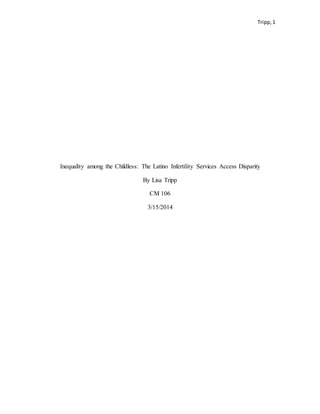This document discusses barriers to Latina access to infertility services in the United States. It notes that Latinas experience infertility at higher rates than non-Hispanic whites but seek treatment at much lower rates. Key barriers include lack of health insurance (30.5% of Latinos are uninsured), low income, low education levels, cultural beliefs, language barriers, and fear of stigma. The document recommends policies like increasing community education to destigmatize infertility, improving provider cultural competence, expanding state insurance mandates to cover infertility services, and amending the Affordable Care Act to include infertility coverage.

![Tripp, 2
A total of 6.2 million Americans suffer from impaired fertility and fecundity, and
only 2.7 million of this group has ever sought treatment (Bitler and Schmidt, 2006). This
infertile treatment-seeking fraction is constituted primarily by “women and couples that are
white, college-educated, and affluent” (Bitler and Schmidt, 2006). So where does this leave
the Latina? Given that Latinas experience a 9.2% chance of infertility compared to a 6.9%
chance among non-Hispanic white females, the Latina infertility status is particularly
concerning. The passage of the Affordable Care Act in 2010 signified a great victory for
Americans, and even more specifically for Latinos across the United States in the realm of
health care. Although the implementation of the Affordable Care Act is now well
underway, Latina access to fertility services continues to remain at an all-time low in
comparison to all other races. A variety of factors influence Latina employment of fertility
services, the sum of which amount to Latina use at half the rate of other groups (Dawson,
et al., 2011). In order to create greater access for Latinas to fertility services, policy makers
and public health leaders alike must come together to implement policy specific to Latina
fertility needs, specifically taking into mind cultural, educational, financial, and insurance
inhibitors to care.
Infertility is a shockingly common condition affecting both men and women of all
races and socioeconomic statuses that often goes unspoken. A variety of sources of
infertility exist, however the fundamental categories include primary infertility, the
“[inability] to conceive a child after a year of having sex without birth control in women
under 35 years old or a 6 month time span in women 35 and older”, and secondary
infertility, applying to “women who cannot carry a fetus to full term, or to women who
have once, but cannot again” (Infertility, 2012). For Americans overall, “after 1 year of](https://image.slidesharecdn.com/67412d9f-bd19-476d-bb2c-d9f01f3ec28c-160720233548/85/final-research-paper-2-320.jpg)


![Tripp, 5
increased prevalence of infertility may also simply be explained by a correlation with low
income.
Average income is perhaps the most important factor determining Latina access to
fertility services. According to the United States Census Bureau, the median household
income of Latinas in the United States is $38,039 (Money, 2012). Of women seeking
fertility services, 53% are unemployed, and 47% are employed (Becker, 2005). A dramatic
income-based infertility service access disparity exists, as “women with income more than
300% of the poverty line [are] 50% more likely to [receive] services” (Bitler and Schmidt,
2006).
Perhaps one of the greatest barriers to infertility services among Latinas is based in
culture. Although modern biomedicine is predominantly practiced today, deep seeded
cultural roots often play an important and complimentary role in self-diagnosis and
treatment among many groups. Homeopathic superstitions and treatments are vital for
many among the Latino community, and many experience “greater familiarity with and
confidence in alternative treatments as their primary source of care” (Dawson, et al.,
2011). For some Latinas, a popular homeopathic diagnosis for infertility is “cold womb,
the primary infertility-related diagnosis women received from practitioners of humoral
medicine” (Becker, 2005). “Cold womb” is popularly treated with “massage, followed by
herbal medicine, usually in the form of a hot tea, accompanied by staying warm, usually at
home” (Becker, 2005). Latina women struggling with infertility issues reported that they
had “been to a masseuse, or ‘sobadora,’ at some point in their quest for fertility” (Becker,
2005). Although these beliefs may be popularly held, their efficacy in treatment of](https://image.slidesharecdn.com/67412d9f-bd19-476d-bb2c-d9f01f3ec28c-160720233548/85/final-research-paper-5-320.jpg)

![Tripp, 7
threat to the survival of Latino families, as the “fear of knowing which member of the
couple is responsible for infertility” deters Latino couples from seeking fertility treatment
(Dawson, et al., 2011). This attitude is further magnified by intense importance and
centrality of children to Latino families.
Given the various seemingly insurmountable barriers Latinas face in seeking
infertility services, infertility in the Latino community has impacts far more reaching than
the simple inability to create children. As can be inferred from the cultural barrier of fear to
the family structure, untreated infertility has a significant impact on marriages. Among
many Latino families “women and men believe that a child is the basis of the marital
relationship: a child is thought to create a bond between the couple and legitimize the
relationship” (Becker, 2005). In the midst of infertility “childless marriages are considered
failures, and there is a widespread expectation that relationships will end if no children are
born.” (Becker, 2004). Not only does infertility threaten Latino relationships, but also may
result in lowered self-worth and emotional detriment. Latinas struggling with infertility
often “become demoralized by repeated failure to conceive and [experience] increased
fault-finding with [their partners] (Becker, 2005). Among Latinas interviewed at fertility
clinics, the majority express “consistent fatalism about fertility” (Dawson, et al., 2011).
Adding to the emotional desparity, “only a few women have jobs they find interesting, and
no one thinks a good job will be an acceptable alternative to having children – each
continues to hope for a conception and reports feeling desperate at the idea that she might
not conceive” (Becker, 2005).
Although a menagerie of barriers exist to seeking infertility services, and the effects
of these barriers are transcending, a variety of avenues exist for individuals seeking fertility](https://image.slidesharecdn.com/67412d9f-bd19-476d-bb2c-d9f01f3ec28c-160720233548/85/final-research-paper-7-320.jpg)





